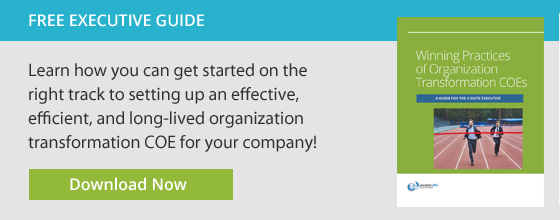Traditional organization design methods don’t always move fast enough to keep up with the pace of change with which businesses must cope. More and more leaders are seeking innovative organization design approaches and solutions to address new and compelling marketplace trends. They are asking themselves: “How valid are these trends, and how might I leverage them to best advantage in my organization?”
On Dec. 1, 2017, AlignOrg Solutions will present a free webinar on this topic, entitled Strategic Organization Design Trends: What is the Right Organization Design Model? In it we will introduce three trending organizational design solutions and clarify what they are and how they can help organizations succeed in today’s marketplace.
The three organization design trends we will explore include:
Agile ways of working – Agile represents a new way of working that breaks complex problems down into more tangible or actionable parts. Because the Agile process encourages the right people from across the organization to rally together to solve a problem, Agile represents a great opportunity to work across organizational boundaries and quickly produce something that delivers value to the customer. Companies wishing to leverage the power of Agile to respond quickly to marketplace demands will need to have or develop structures or mechanisms to support this new approach to value creation. Attend our webinar to discover how and why Agile might fit with your company’s goals.
Digital transformation – In our book, Mastering the Cube, we use the analogy of a Rubik’s Cube to represent the organization systems within an organization, and how they align with strategy. It is possible to solve a Rubik’s cube very, very quickly: the world record for a human being is under 5 seconds. But as fast as that is, it’s now possible for a robot to solve the Rubik’s Cube in under 2 seconds: a mind-bogglingly fast speed that illustrates the power of digital capabilities and their ability to transform work.
Human beings will always be needed for work that requires judgement and creativity, but there are very many activities—even high-level activities like legal contracts or medical diagnoses—currently performed by humans that in time may be done faster and better using artificial intelligence. Our webinar will explore what these changes may mean for traditional organizational structures, and how they will need to adapt to this trend while taking advantage of capabilities that digital technology brings.
Virtual connected organizations – Historically, companies grew and gained power and influence by controlling resources and the means of production. Now, we’re seeing the rise of a new type of organization that doesn’t own or control the things that historically led to value in organizations. Instead, they create value through technology, networking, and enabling connections and relationships.
Take Marriott, for example. Originally, Marriott owned its own properties and hotels, but over time they began to franchise those out to the point where it doesn’t own any hotels at all any more, it just franchises and manages them. Now, we are seeing the rise of companies like Airbnb and WeWork that eschew even management: their sole function is to help connect people with property to people who want to use it.
These and other companies facilitating the creation of value without owning or controlling anything are doing it in ways that are powerful but are not the traditional ways power and resources were controlled. Join us to explore the implications both for companies that are heavily capital intensive, and for those trying to deliver value through networked organizations.
Strategic Organization Design Trends: What is the Right Organization Design Model? is intended for anyone interested in finding the optimal organization design models for their organization by understanding and anticipating future trends: specifically C-suite executives and senior business managers, heads of global functions and regional operations, HR leaders and OE/talent professionals, performance and change managers, and anyone interested in designing organizations to drive competitive differentiation. We look forward to seeing you there!







